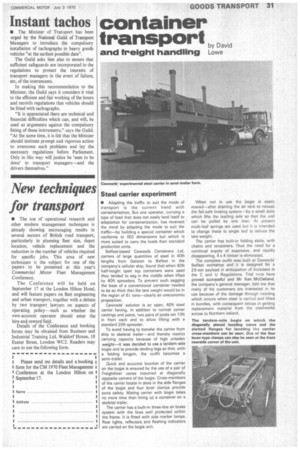Steel carrier experiment
Page 33

If you've noticed an error in this article please click here to report it so we can fix it.
• Adapting the traffic to suit the mode of transport is the current trend with containerization. But one operator, carrying a type of load that does not easily lend itself to adaptation for containerization, has reversed the trend by adapting the mode to suit the traffic—by building a special container which conforms to ISO dimensions but which is more suited to carry the loads than standard production units.
Belfast-based Cawoods Containers Ltd, carriers of large quantities of steel in 40ft lengths from Garston to Belfast in the company's cellular ship, found that when 40ft half-height open top containers were used they tended to sag in the middle when lifted by 40ft spreaders. To prevent such sagging the base of a conventional container needed to be so thick that the tare weight would be in the region of 61 tons—clearly an uneconomic proposition, Cawoods' solution is an open, 40ft steel carrier having, in addition to normal corner castings and posts, two pairs of posts set Oft in from each end to allow lifting with a standard 20ft spreader.
To avoid having to transfer the carrier from ship to skeletal trailer--and thereby restrict carrying capacity because of high unladen weight—it was decided to use a tandem-axle bogie and to provide landing legs so that, with a folding kingpin, the outfit becomes a semi-trailer.
Quick and accurate location of the carrier on the bogie is ensured by the use of a pair of Freightliner cones mounted at diagonally opposite corners of the bogie. Cross-members of the carrier locate in slots in the side flanges of the bogie and four lever clamps provide extra safety. Mating carrier with bogie takes no more time than lining up a container on a skeletal trailer.
The carrier has a built-in three-line air brake system with the lines well protected within the frame. It is fitted with side marker lamps. Rear lights, reflectors and flashing indicators are carried on the bogie unit. When not in use the bogie is easily moved—after draining the air tank to release the fail-safe braking system—by a small dolly which lifts the leading axle so that the unit can be pulled by one man. Az present multi-leaf springs are used but it is intended to change these to single leaf to reduce the tare weight.
The carrier has built-in folding skids, with chains and tensioners. Thus the need for a continual supply of expensive, and rapidly disappearing, 4 x 4 timber is eliminated.
The complete outfit was built at Cawoods' Belfast workshop and it is designed for a 25-ton payload in anticipation of increases in the C and U Regulations. Trial runs have proved successful and Mr Ken McClelland, the company's general manager, told me that many of his customers are interested in its use because of the damage through twisting which occurs when steel is carried and lifted in bundles, with consequent delays in getting replacement material from the steelworks across to Northern ireland.




































































































































































